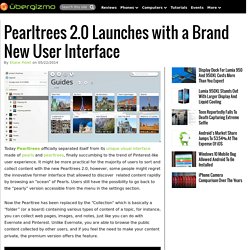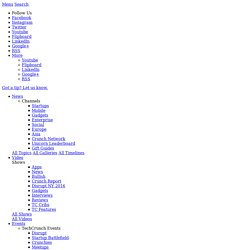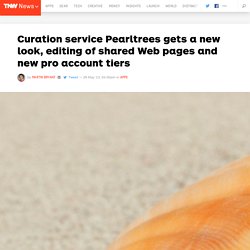

Pearltrees 2.0 Launches with a Brand New User Interface. Today Pearltrees officially separated itself from its unique visual interface made of pearls and pearltrees, finally succumbing to the trend of Pinterest-like user experience.

It might be more practical for the majority of users to sort and collect content with the new Pearltrees 2.0, however, some people might regret the innovative former interface that allowed to discover related content rapidly by browsing an “ocean” of Pearls. Users still have the possibility to go back to the “pearly” version accessible from the menu in the settings section. Now the Pearltree has been replaced by the “Collection” which is basically a “folder” (or a board) containing various types of content of a topic, for instance, you can collect web pages, images, and notes, just like you can do with Evernote and Pinterest.
Pearltrees launches its cloud storage and file sharing service. The Pearltrees the web and mobile content curation tool launches its online storage and file sharing service.

Based on your storage needs you can opt for a free or premium account Established in 2008, Pearltrees is a collaborative bookmark manager allowing each user to share web content (called "pearls"), and discover new content. Its focus on the visual presentation of shared content, the latter being classified into tree structures and arranged by theme. Initially dedicated to the curation of web content, Pearltrees has rapidly expanded features (collaborative and productivity).
Pearltrees now offers its users to store all types of files on their virtual space. The free offer - 250 MB of storage space 5GB - $1.59/month 25GB - $3.19/month 100GB - $8.49/monthThis new service will also allow the preview stored documents, share them with other users, annotate or comment them. Pearltrees Brings New Editing Features To Its Curation Service. Pearltrees, the Paris-based curation and bookmarking service, is launching a major update to its service today that brings a number of new editing tools to the site.

Pearltrees users were already able to write and save notes, as well as store images and other content on the service. Now, they will also be able to annotate the texts they saved from around the web, caption images and use the service’s new WYSIWYG text editor to write more complex notes. The service is also adding a couple of new personalization features that allow users to add a new background to their collections and change the overall look and feel of the collection.
The new editor, as well as the ability to caption images and illustrate their collections with handpicked images will be available to all users, while the more advanced personalization and annotation tools will only be available for paying Pearltrees Premium subscribers. 2. How does or will Pearltrees make money? Pearltrees. Pearltrees (@pearltrees) Welcome. Pearltrees Radically Redesigns Its Online Curation Service To Reach A Wider Audience. Pearltrees, the Paris-based online curation service that launched in late 2009, was always known for its rather quirky Flash-based interface that allowed you to organize web bookmarks, photos, text snippets and documents into a mindmap-like structure.

For users who got that metaphor, it was a very powerful service, but its interface also presented a barrier to entry for new users. Today, the company is launching a radical redesign that does away with most of the old baggage of Pearltrees 1.0. Gone are the Flash dependency, the tree diagrams, the little round pearls that represented your content and most everything else from the old interface. Here is what Pearltrees 1.0 looked like: And here is the new version: Pearltrees’ mission is still to allow you to organize everything you want on the service (in that respect, it almost competes with Evernote). 3. “We took what everybody liked about the old version and put it into a visualization that everybody could grasp right away,” Lamothe said. Pearltrees: 3 years and €8.5 million later, there's finally talk of a business model. Pearltrees Gets a New Look, New Features and New Premium Tiers.
Pearltrees, the social curation service that helps you organise Web content, photos and notes (‘pearls’) into mindmap-style ‘trees’, is today unveiling a new look, new features for paying users and revised pro account tiers.

Pearltrees was launched in December 2010 and now boasts two million monthly active users, collecting over 50,000 links every day. The new UI, codenamed ‘Asimov’ by the French startup, is designed to provide a coherent, simpler experience across the Web, iOS and a forthcoming Android version. There’s nothing enormously different about it, although there’s now an Apple-style ‘dock’ at the bottom of the page for universal options and a subtly more friendly look that uses responsive design to optimize the layout for different screen sizes. The updated iOS version, which will be available as soon as it’s approved by Apple, promises to get rid of one my biggest bugbears when it comes to curation apps – the Safari bookmarklet. Now, there are three paid tiers: Pearltrees Extension.